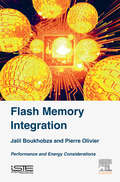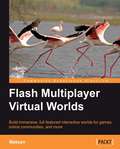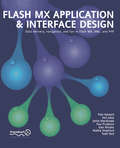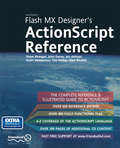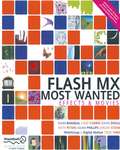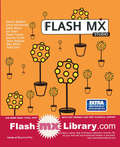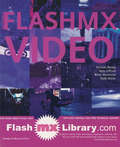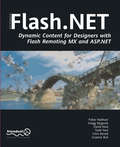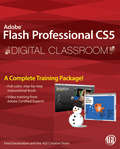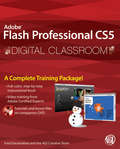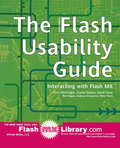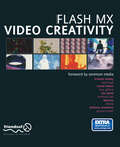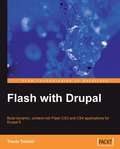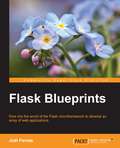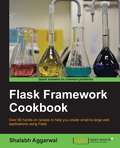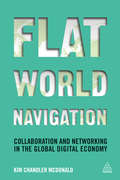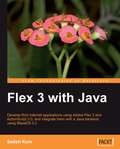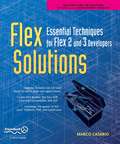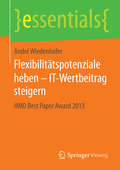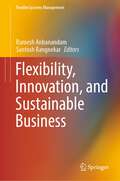- Table View
- List View
Flash Memory Integration: Performance and Energy Issues
by Jalil Boukhobza Pierre Olivier4 zettabytes (4 billion terabytes) of data generated in 2013, 44 zettabytes predicted for 2020 and 185 zettabytes for 2025. These figures are staggering and perfectly illustrate this new era of data deluge. Data has become a major economic and social challenge. The speed of processing of these data is the weakest link in a computer system: the storage system. It is therefore crucial to optimize this operation. During the last decade, storage systems have experienced a major revolution: the advent of flash memory. Flash Memory Integration: Performance and Energy Issues contributes to a better understanding of these revolutions. The authors offer us an insight into the integration of flash memory in computer systems, their behavior in performance and in power consumption compared to traditional storage systems. The book also presents, in their entirety, various methods for measuring the performance and energy consumption of storage systems for embedded as well as desktop/server computer systems. We are invited on a journey to the memories of the future. Ideal for computer scientists, featuring low level details to concentrate on system issuesTackles flash memory aspects while spanning domains such as embedded systems and HPCContains an exhaustive set of experimental results conducted in the Lab-STICC laboratoryProvides details on methodologies to perform performance and energy measurements on flash storage systems
Flash Multiplayer Virtual Worlds: Build Immersive, Full-featured Interactive Worlds For Games, Online Communities, And More
by MakzanThis is a step-by-step, hands-on guide that is filled with examples and screenshots of building a multiplayer virtual world. The virtual world is built gradually; each chapter in the book sequentially develops the virtual world. The author explains the fundamentals with examples from existing virtual worlds such as Club Penguin, Mole, Dofus, and World of Warcraft. If you are a Flash or an ActionScript developer who wants to build powerful and immersive multiplayer games, this book is for you. This book assumes that you have some experience with ActionScript 3.0.
Flash MX Application And Interface Design: Data delivery, navigation, and fun in Flash MX, XML, and PHP
by Connor McDonald Paul Prudence Gerald YardFace Peter Aylward Fay Rhodes Robbie Shepherd Ken JokolThe days of Flash as a creative luxury are long gone. After months of downsizing, Flash creativity has been on a huge rationalization program. It is no longer enough to present animation in millions of colors and a hundred transparencies. It is no longer sufficient to provide interactivity and dynamism for their own sake. The purpose of this collection is to show how designers have taken Flash and made it work for its supper. What we discover is a series of creations that place Flash at the hub of cutting edge web content. The end result is a snapshot of Flash as the ideal medium. In these amazing examples, we see the software pushed to its limits to create unbeatable applications—a collapsible family tree, an interactive video learning system, and a drawing tool, capable of running online! Beyond this, we dip into the back-end capabilities to look at how to improve Flash still further. Some staple XML and PHP routines are brought in to add a bit of spice, while Flash's mysterious sharedObject command is hunted down and tamed to create a hybrid Tamagotchi houseplant—perfectly suited to lure surfers back to your website!
Flash MX Designer's ActionScript Reference
by Tim Parker Fay Rhodes Jennifer Dehaan Sham Bhangal John Davey Scott MebbersonIf you're serious about Flash design, and if you want to push your ideas to the very limits of possibility in Flash MX, then this book and CD are your indispensable companions. This package combines two vital elements: the most comprehensive and in-depth reference resource for Flash MX ActionScript Rich, and practical tutorials on using ActionScript effectively in your Flash movie design. We've packed in 20 chapters of tutorials, hundreds of detailed reference entries, and hundreds of example FLAs and SWFs. The CD reproduces and expands the complete ActionScript dictionary, providing you with a comprehensive and portable reference tool. To gain an idea of the CD's content, view our online demonstration. You can view all the dictionary's entries, but only the first 30 or so are functional. Our aim has been to make this book the best Flash MX ActionScript resource, bar none—the book that you'll keep on your desk and never exhaust.
Flash MX Most Wanted
by David Doull Chad Corbin Adam Phillips Maria Stone Keith Peters Sham Bhangal Gerald YardFaceThe authors give you all you need to know to create the most commonly requested and popular Flash visual effects and movies on the web with fast and fun examples.
Flash MX Studio
by Connor McDonald Jon Steer Jerome Turner Abe White Gerald YardFace Matthew Baldwin Steve Webster David TuduryFlash MX Studio takes your raw Flash talent and multiplies its potency by focusing it on real-world web design situations. In the heady days of the late 1990s, designers were trying their hand at anything and everything they could lay their hands on. Now the marketplace is seriously focused, and serious Flash designers have to know exactly what they're doing and why. These days, it's all about functionality over experimentation, justification over style. It's all about maturity. The design must fit the job specs, and this book shows the reader how to fulfill these requirements and more. This book examines all the avenues open to professional or aspiring professional Flash MX designers. It takes a look at advanced uses of the new MX features, such as components and the Drawing API, and gives guidance on building whole new structures for animation, Dynamic Content, PHP, ColdFusion MX, XML, video, audio and audiovisual formats. Never before has so much power been so accessible to the web designer. This book is designed to put that power in your hands. Flash MX Studio has been broken into four sections to address the most common needs for the Flash designer. First off, Jamie McDonald provides five chapters on site presentation and the principles of web design. These opening chapters take a look at how to create slick, professional-level sites, involving Flash MX's new drawing and motion capabilities and interactive techniques. The second section concentrates on ActionScript. Flash's resident coding environment is crucial to master, and taps into Flash's great strength—intuitive and interactive applications. Keith Peters and Todd Yard have buddied up on this section, and examine some of the most advanced ActionScript techniques around. Be warned—this section is not for the faint-hearted! Section three takes a look at Flash MX's greatly improved visual, audio and audiovisual capabilities. Its three chapters, written by Jez Turner and Alex White, concentrate on building a single site aimed at displaying rich media content. The final section is devoted to expounding a few myths about dynamic content using Flash. Its four chapters talk about general practice, before focusing in on specific areas, including introductions to PHP and XML, together with a look at Macromedia's brand new ColdFusion MX.
Flash MX Video
by Kristian Besley Brian Monnone Hoss Gifford Todd MarksLet's make movies! Interactive movies, totally integrated into your Flash interface! With Macromedia Flash MX you have the power to import digital video and sound, and manipulate them just like any other media object. That's a whole world of design possibilities. This book hopes to take you through all you'll need to know about producing such wonderful sites. The first section will give you a thorough grounding in how best to import your video and sound into Flash and the many different ways that you can manipulate it once it's in there. Then, in the second section, we'll go through a complete real-world case study from pre-production on the video to final output on the web and CD-ROM. Finally, we'll see how you can apply use some advanced ActionScripting with video, and create a fully object-orientated sound and video playing Flash component that you'll be able to use time and time again. The inclusion of video support is the most noticeable and exciting feature in Flash MX - viewers who have the tiny Flash plug-in installed can now see video material that would otherwise necessitate the lengthy downloads and clunky interfaces of other web video plug-ins. This book is the guide you need for this exciting new universe, offering inspiration and technical guidance in equal measures. This book assumes no knowledge beyond an ability to work with Flash MX's interface, and is not intended for those with substantial digital video experience. As such, this book does not assume that the reader has access to expensive video-editing software. All you need for this book is access to Flash MX, and some imagination.
Flash .NET: Dynamic Content For Designers With Flash Remoting Mx And Asp.net
by Gerald YardFace David Neal Pallav Nadhani Graeme Bull Chris BizzellThe absolute cutting edge for application development at the moment is using Macromedia's Flash MX (the premier software for designing fantastic looking interfaces) with Microsoft's .NET framework (tremendously powerful server-side technology). Combining these technologies has been greatly aided by the release of Macromedia's Flash Remoting MX, which is covered fully in this book. Designers and developers involved in the creation of this technology impart their knowledge to you in this book through extensive case studies. Flash Remoting is not the only way to combine these technologies, however, so this book will fully cover Flash/.NET integration using ASP.NET. This book is for readers who are looking to integrate their Flash movies with a .NET-enabled back-end. It assumes no prior knowledge of server-side technologies, but does require knowledge of Flash MX and ActionScript.
Flash Professional CS5 Digital Classroom (Digital Classroom)
by Fred Gerantabee AGI Creative TeamLearn Flash in a flash with this full-color book and video training package! Adobe Flash is used by designers, game programmers, and hobbyists to create interactive Web sites, digital experiences, and mobile content. The latest release of Flash promises exciting new capabilities and this book-and-video training package makes learning the new features of Flash less intimidating. Fifteen self-paced lessons encourage you to discover essential skills and explore new aspects of Flash. The tutorials featured in the videos are each approximately five minutes long and supplement the concepts and topics covered in the lessons. Features full-color, step-by-step tutorials that complement the topics covered in each lesson Demonstrates the basics of using the newest release of Flash, such as using layers and instances to build animation sequences Covers intermediate and advanced capabilities, such as using ActionScript to create interactive Web page components Jam-packed with information, this book takes you from Flash basics through intermediate-level topics and helps you find the information you need in both print and video. Note: DVD and other supplementary materials are not included as part of eBook file. These materials are available for download upon purchase.
Flash Professional CS5 Digital Classroom (Digital Classroom)
by Fred Gerantabee AGI Creative TeamLearn Flash in a flash with this full-color book and video training package! Adobe Flash is used by designers, game programmers, and hobbyists to create interactive Web sites, digital experiences, and mobile content. The latest release of Flash promises exciting new capabilities and this book-and-video training package makes learning the new features of Flash less intimidating. Fifteen self-paced lessons encourage you to discover essential skills and explore new aspects of Flash. The tutorials featured in the videos are each approximately five minutes long and supplement the concepts and topics covered in the lessons. Features full-color, step-by-step tutorials that complement the topics covered in each lesson Demonstrates the basics of using the newest release of Flash, such as using layers and instances to build animation sequences Covers intermediate and advanced capabilities, such as using ActionScript to create interactive Web page components Jam-packed with information, this book takes you from Flash basics through intermediate-level topics and helps you find the information you need in both print and video. Note: DVD and other supplementary materials are not included as part of eBook file. These materials are available for download upon purchase.
The Flash Usability Guide: Interacting with Flash MX
by Andrew Kirkpatrick David Doull Dan Waters Bob Regan Peter Pinch Chris McGregorWhat this book is about . . . . . . . . . . . . . . . . . . . . . . . . . . . . . . . . . . . . . . . . . . . . . . . . . . . . . . . . . . . . . . . . . . . . . . . . . . . . . . . . . . . . . . . . . . . . . . . . . . . . . . . . . . . . . . . . . . . . . . . . . . . . 1 What we expect you to know . . . . . . . . . . . . . . . . . . . . . . . . . . . . . . . . . . . . . . . . . ; . . . . . . . . . . . . . . . . . . . . . . . . . . . . . . . . . . . . . . . . . . . . . . . . . . . . . . . . . . . . . . . . . . . . . . . . 2 How the book looks . . . . . . . . . . . . . . . . . . . . . . . . . . . . . . . . . . . . . . . . . . . . . . . . . . . . . . . . . . . . . . . . . . . . . . . . . . . . . . . . . . . . . . . . . . . . . . . . . . . . . . . . . . . . . . . . . . . . . . . . . . . . . . . . . . . . 3 Flash vs. Usability 1 Flash in control . . . . . . . . . . . . . . . . . . . . . . . . . . . . . . . . . . . . . . . . . . . . . . . . . . . . . . . . . . . . . . . . . . . . . . . . . . . . . . . . . . . . . . . . . . . . . . . . . . . . . . . . . . . . . . . . . . . . . . . . . . . . . . . . . . . . . . . . . . . . . . 8 Too much power? . . . . . . . . . . . . . . . . . . . . . . . . . . . . . . . . . . . . . . . . . . . . . . . . . . . . . . . . . . . . . . . . . . . . . . . . . . . . . . . . . . . . . . . . . . . . . . . . . . . . . . . . . . . . . . . . . . . . . . . . . . . . . . . . 9 Too little restraint? . . . . . . . . . . . . . . . . . . . . . . . . . . . . . . . . . . . . . . . . . . . . . . . . . . . . . . . . . . . . . . . . . . . . . . . . . . . . . . . . . . . . . . . . . . . . . . . . . . . . . . . . . . . . . . . . . . . . . . . . . . . . 11 Whose computer is it anyway? . . . . . . . . . . . . . . . . . . . . . . . . . . . . . . . . . . . . . . . . . . . . . . . . . . . . . . . . . . . . . . . . . . . . . . . . . . . . . . . . . . . . . . . . . . . . . . . . . . . . . . 14 Designers use the Web differently . . . . . . . . . . . . . . . . . . . . . . . . . . . . . . . . . . . . . . . . . . . . . . . . . . . . . . . . . . . . . . . . . . . . . . . . . . . . . . . . . . . . . . . . . . . . . . . . 15 Who has the need for speed? . . . . . . . . . . . . . . . . . . . . . . . . . . . . . . . . . . . . . . . . . . . . . . . . . . . . . . . . . . . . . . . . . . . . . . . . . . . . . . . . . . . . . . . . . . . . . . . . . . . . . . . . 18 Biting the hand that feeds . . . . . . . . . . . . . . . . . . . . . . . . . . . . . . . . . . . . . . . . . . . . . . . . . . . . . . . . . . . . . . . . . . . . . . . . . . . . . . . . . . . . . . . . . . . . . . . . . . . . . . . . . . . . . . 19 Year 2000: the Flash backlash . . . . . . . . . . . . . . . . . . . . . . . . . . . . . . . . . . . . . . . . . . . . . . . . . . . . . . . . . . . . . . . . . . . . . . . . . . . . . . . . . . . . . . . . . . . . . . . . . . . . . . . . . . . . . . . . 23 Addressing the critics . . . . . . . . . . . . . . . . . . . . . . . . . . . . . . . . . . . . . . . . . . . . . . . . . . . . . . . . . . . . . . . . . . . . . . . . . . . . . . . . . . . . . . . . . . . . . . . . . . . . . . . . . . . . . . . . . . . . . . . . 24 Accessibility . . . . . . . . . . . . . . . . . . . . . . . . . . . . . . . . . . . . . . . . . . . . . . . . . . . . . . . . . . . . . . . . . . . . . . . . . . . . . . . . . . . . . . . . . . . . . . . . . . . . . . . . . . . . . . . . . . . . . . . . . . . . . . . . 28 Modified links . . . . . . . . . . . . . . . . . . . . . . . . . . . . . . . . . . . . . . . . . . . . . . . . . . . . . . . . . . . . . . . . . . . . . . . . . . . . . . . . . . . . . . . . . . . . . . . . . . . . . . . . . . . . . . . . . . . . . . . . . . . . 28 Plug-ins . . . . . . . . . . . . . . . . . . . . . . . . . . . . . . . . . . . . . . . . . . . . . . . . . . . . . . . . . . . . . . . . . . . . . . . . . . . . . . . . . . . . . . . . . . . . . . . . . . . . . . . . . . . . . . . . . . . . . . . . . . . . . . . . . . . . . . . . 28 Internationalization and localization . . . . . . . . . . . . . . . . . . . . . . . . . . . . . . . . . . .
Flash Video Creativity
by Murat Bodur Hoss Gifford Diana Johnson Leonhard Lass Anthony Onumonu Kristian Besley Neal Boyd Jerome Turner Ken Jokol Tim Hawkinsby Bruce Herbert and Diana Johnson ofSorenson Media Creative boundaries are being blown apart as Macromedia Flash MX ushers in a new era of moving images on the Internet. At its launch, analysts predicted that the Flash Player would transform itself from being a lightweight animation tool" to "the de facto technology for simple web interactivity5* (Randy Souza, Forrester). Since then though, Flash developers combining vector animation and video have proven that it's capable of much, much more than "simple web interactivity". We're still just beginning to scratch the surface of the possibilities it opens up to us, but already it looks like Flash MX is becoming the key technology for pushing video creativity on the Web to a new whole level. Understandably, many people look at Flash as just another way to deliver video on the Web, one more program for showing movies on your desktop. Well, it can certainly do that - but there's a whole lot more it can do besides! You can use ActionScript to add custom controls, determine a video playback sequence, or mask your video with a custom shape. You can use layering to create special effects, design custom templates for e-learning applications, and use lightweight video streams along with Flash animation in rich media e-mail campaigns.
Flash with Drupal
by Travis TidwellThis book takes a step-by-step approach to building Flash applications for use with the Drupal Content Management System. In each chapter, you walk through the evolution of a real Flash application designed for Drupal. Every chapter builds on the previous one by presenting a more challenging feature for each additional chapter. This book is written for developers who wish to build dynamic flash applications. Although we will be using Drupal for our Content Management System, the lessons learned within this book can easily be applied to other content management systems such as Joomla or WordPress. Because of this, you are not assumed to be familiar with Drupal. Any interaction with Drupal will be described in full detail so that anyone can follow along. As for Flash, it is not necessary to be familiar with how to use Flash since that too will be covered within this book. However, it is recommended that you have some modest understanding of ActionScript and PHP since there are many code examples within this book.
Flask Blueprints
by Joel PerrasDive into the world of the Flask microframework to develop an array of web applications About This Book • Structure, compose, and build powerful Flask HTML-based applications and JSON/XML-based APIs using advanced application design patterns • Integrate third-party Flask extensions for tasks such as social authentication, sending emails, and interacting with databases and cache layers • Build a series of Flask applications of increasing complexity Who This Book Is For If you are a Python web developer who has developed basic Flask applications and now wants to build a series of more complex web applications, then this is the book for you. What You Will Learn • Use the virtualenv Python package to effectively isolate your development environments • Convert a simple one-file Flask application into a more full-fledged multi-package application • Integrate Flask-Login for simple user authentication, Flask-WTF for forms, and Flask-SQLAlchemy for database interactions • Explore URL routing and dispatching in a blueprint structured application • Create your own signals and consume them within your application • Learn to leverage Werkzeug, the WSGI library that powers much of Flask • Implement custom exceptions for handling non-20x response codes • Write your own CLI tools for administrative and development tasks of your Flask application using Flask-Script/Click • Build your Flask extensions to encapsulate reusable behaviors across your applications • Integrate your application with open source JavaScript-based graphing libraries to create simple data visualizations In Detail Flask is a small but powerful web development framework for Python. Though Flask is termed a micro-framework, it is no way lacking in functionality; there are many extensions available to Flask which helps it to function at the same level as other large frameworks such as Django and Ruby on Rails. This book will demonstrate how to develop a series of web application projects with the Python web micro-framework, and leverage extensions and external Python libraries and APIs to extend the development of a variety of larger and more complex web applications. The book will start by explaining Python's Virtualenv library and how to create and switch between multiple virtual environments. You'll first build an SQL database-backed application, which will use Flask-WTF, Flask-SQLAlchemy, Jinja templates, and other methods. Next you'll move on to a timeline application, built using concepts including pytest-Flask, the Blinker package, data modelling for user timelines, exception handling, and creating and organizing CLI tools. Moving on, you'll discover how to implement a photo timeline application where you'll explore topics such as writing and running celery tasks, API error handling and testing, and Werkzeug middlewares. Finally, the book walks you through creating an application which fetches data from GitHub and stores it locally. You will also learn how to install and configure Flask-Click extension. Style and approach This book covers how to effectively use the Flask micro-framework to develop a series of web applications. Each chapter focusses on the development of an application increasing in complexity with easy steps to follow.
Flask Framework Cookbook
by Shalabh AggarwalIf you are a web developer who wants to learn more about developing applications in Flask and scale them with industry-standard practices, this is the book for you. This book will also act as a handy tool if you are aware of Flask's major extensions and want to make the best use of them. It is assumed that you have knowledge of Python and a basic understanding of Flask. If you are completely new to Flask, reading the book from the first chapter and going forward will help in getting acquainted with Flask as you go ahead.
Flat World Navigation: Collaboration and Networking in the Global Digital Economy
by Kim Chandler McDonaldFlat World Navigation introduces the new future of work in the 'flattened world' of the new digital attention-based economy, where real connections can be made in seconds across departments, businesses, cultures and countries. Combining the best elements of networking, social media outreach and collaborative techniques, flat world navigation is an essential capability to build and maintain relationships between colleagues, customers and partners. Employees who can transform themselves into flat world navigators, experts in mediating these powerful relationships and bringing the customer into the conversation, will mean the difference between success and failure in business.Flat World Navigation includes exclusive insights and interviews with international business leaders who successfully use flat world navigation skills, such as the Emmy-winning former NBC and Wall Street Journal reporter Kare Anderson, Sandy Carter at IBM, Gordon Feller at CISCO Systems, Aria Finger at DoSomething.org, Louise Guido at ChangeCorp, Jeffrey A. Finkle at the International Economic Development Council and Carolyn Lawrence, CEO of Women of Influence.This book is grounded in real-world experience with insights and advice to build your skills base and empower the next generation of business people. Additionally, it is of great use to business owners and managers looking to effectively leverage the skills of these flat world navigators, whose critical role brings attention to ideas, products and services and, as such, must be part of a successful business strategy.
Flat World Navigation: Collaboration and Networking in the Global Digital Economy
by Kim Chandler McDonaldFlat World Navigation introduces the new future of work in the 'flattened world' of the new digital attention-based economy, where real connections can be made in seconds across departments, businesses, cultures and countries. Combining the best elements of networking, social media outreach and collaborative techniques, flat world navigation is an essential capability to build and maintain relationships between colleagues, customers and partners. Employees who can transform themselves into flat world navigators, experts in mediating these powerful relationships and bringing the customer into the conversation, will mean the difference between success and failure in business.Flat World Navigation includes exclusive insights and interviews with international business leaders who successfully use flat world navigation skills, such as the Emmy-winning former NBC and Wall Street Journal reporter Kare Anderson, Sandy Carter at IBM, Gordon Feller at CISCO Systems, Aria Finger at DoSomething.org, Louise Guido at ChangeCorp, Jeffrey A. Finkle at the International Economic Development Council and Carolyn Lawrence, CEO of Women of Influence.This book is grounded in real-world experience with insights and advice to build your skills base and empower the next generation of business people. Additionally, it is of great use to business owners and managers looking to effectively leverage the skills of these flat world navigators, whose critical role brings attention to ideas, products and services and, as such, must be part of a successful business strategy.
Flatbed Scanner (large print)
by RnibThis page shows two labelled views of a flatbed image scanner. There is a locator dot shown, which will be at the top left of the page when the image is the right way up. At the top right of the page the scanner is seen from the top with the lid removed and at the bottom right it is seen from the side. The labels with leader lines are to the left of the page. Top view (with lid removed): This view is on the top right of the page. It shows the scanner buttons to the left and the scanner bed to the right. The power switch is at the top and buttons controlling other functions, such as scan and copy, are down the page. To the right of this is the rectangular, clear glass scanner bed where documents to be scanned are put with images face down on the glass. Side view: The side view of the scanner is at the bottom right of the page. It shows the lid at the top opened to load a document. Down the page from this is a document on the scanner bed and further down is the casing of the scanner. To the left, one of the control buttons can be found.
Flatbed Scanner (UEB contracted)
by RnibThis page shows two labelled views of a flatbed image scanner. There is a locator dot shown, which will be at the top left of the page when the image is the right way up. At the top right of the page the scanner is seen from the top with the lid removed and at the bottom right it is seen from the side. The labels with leader lines are to the left of the page. Top view (with lid removed): This view is on the top right of the page. It shows the scanner buttons to the left and the scanner bed to the right. The power switch is at the top and buttons controlling other functions, such as scan and copy, are down the page. To the right of this is the rectangular, clear glass scanner bed where documents to be scanned are put with images face down on the glass. Side view: The side view of the scanner is at the bottom right of the page. It shows the lid at the top opened to load a document. Down the page from this is a document on the scanner bed and further down is the casing of the scanner. To the left, one of the control buttons can be found.
Flatbed Scanner (UEB uncontracted)
by RnibThis page shows two labelled views of a flatbed image scanner. There is a locator dot shown, which will be at the top left of the page when the image is the right way up. At the top right of the page the scanner is seen from the top with the lid removed and at the bottom right it is seen from the side. The labels with leader lines are to the left of the page. Top view (with lid removed): This view is on the top right of the page. It shows the scanner buttons to the left and the scanner bed to the right. The power switch is at the top and buttons controlling other functions, such as scan and copy, are down the page. To the right of this is the rectangular, clear glass scanner bed where documents to be scanned are put with images face down on the glass. Side view: The side view of the scanner is at the bottom right of the page. It shows the lid at the top opened to load a document. Down the page from this is a document on the scanner bed and further down is the casing of the scanner. To the left, one of the control buttons can be found.
Flex 3 with Java
by Satish KoreThe author's experience in creating applications using Flex enables him to share insights on using it effectively in a clear, simple, and concise manner. His approach will help you gain hands-on programming experience in Flex 3 and ActionScript 3.0. The book focuses on important features of Flex 3 and ActionScript 3.0 and gives clear instructions and precise code examples to explain features and ensure that you actually learn as you read. This book is a good starting point for any developer with a little experience in Java programming to get going with Adobe Flex 3 and ActionScript 3.0 development. You may be a software developer/professional who wishes to learn and understand Flex 3 technology for developing Rich Internet Applications. If you are a system analyst who wants to explore and understand Flex 3 then this is an ideal book for you.
Flex Solutions: Essential Techniques for Flex 2 and 3 Developers
by Marco CasarioThis book is for any Flex developer who is comfortable with the basics and wants to take their knowledge to the next level. It provides a library of over 100 solutions to common problems. Each solution takes you through the workings of the example step-by-step and then presents some expert's tips, which will take your understanding further and give you unique insights into Flex development. Coverage includes Flex 2 components, charting, working with remote data, data validation, displaying data with list based controls, controlling the look and feel of applications, application security, and working with dynamic data sources.
Flexibilisierung der automatischen Teilebereitstellung in Montageanlagen (iwb Forschungsberichte #87)
by Markus RocklandFlexibilitätspotenziale heben – IT-Wertbeitrag steigern: HMD Best Paper Award 2013 (essentials)
by André WiedenhoferIn den vergangenen Jahren nahm die Veränderungsgeschwindigkeit in den Unternehmen stetig zu. Die wachsende Globalisierung, die Auswirkungen der Krise und die rasch wandelnden Technologien haben bewährte Geschäftsmodelle grundlegend in Frage gestellt. Die ständige Anpassung wird „business as usual“. Dadurch bedingt ändern sich die Anforderungen an die betriebliche Informationstechnologie (IT). Um einen wesentlichen Wertbeitrag zu generieren, muss die IT der marktinduzierten Unsicherheit mit einem angemessenen Grad an Flexibilität begegnen. In Anlehnung an die ressourcenorientierte Theorie stellt André Wiedenhofer die IT als wesentliche Kernkompetenz dar. Da Unsicherheit in der Literatur bisher kaum Beachtung gefunden hat und Flexibilitätspotenziale scheinbar noch nicht ausgeschöpft sind, soll der Beitrag Handlungsempfehlungen geben, wie die IT langfristig ihren Wertbeitrag organisatorisch verbessern kann.
Flexibility, Innovation, and Sustainable Business (Flexible Systems Management)
by Ramesh Anbanandam Santosh RangnekarThis book contains practical experiences, knowledge, and insights in the evolution, formulation, and implementation of strategies and models for flexibility, innovation, and sustainable business. The book discussed the increasing significance of a flexible approach by businesses as much as possible in every area of their work—from employment policies to supply chain management (SCM). It further links this flexible approach to a sustainability strategy, which is necessary to be competitive today and in the future. This business approach is necessary to create long-term value by considering how a given organization operates in the ecological, social, and economic environment. This is linked to the next theme of the book—innovation—which is fundamental for a business to improve its processes, develop new and improved products and services for the market, increase its efficiency, and, most importantly, get better profitability. The book also delves into another buzz word in business—analytics. Companies have widely embraced the use of analytics to streamline operations and improve processes. The book explores all these critical emerging areas through the chapters in its five sections and is invaluable for management students and researchers, practicing business managers, consultants, professional institutions, and government and corporate organizations.
